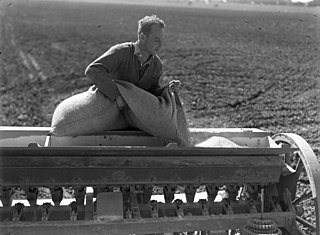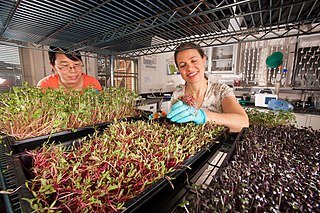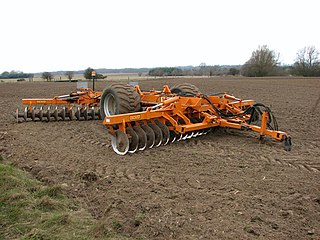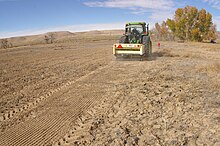
Tillage is the agricultural preparation of soil by mechanical agitation of various types, such as digging, stirring, and overturning. Examples of human-powered tilling methods using hand tools include shoveling, picking, mattock work, hoeing, and raking. Examples of draft-animal-powered or mechanized work include ploughing, rototilling, rolling with cultipackers or other rollers, harrowing, and cultivating with cultivator shanks (teeth).

Sowing is the process of planting seeds. An area that has had seeds planted in it will be described as a sowed or sown area. When sowing it is important to:
The stale seed bed or false seed bed method is a weed control technique used at both the farm and garden scales. In this that the young weeds can then be easily eliminated. By destroying them early, the farmer or gardener eliminates most of that season's annual weeds, which reduces their labor and improves their crop yields.

Weed control is a type of pest control, which attempts to stop or reduce growth of weeds, especially noxious weeds, with the aim of reducing their competition with desired flora and fauna including domesticated plants and livestock, and in natural settings preventing non native species competing with native species.

A seed drill is a device used in agriculture that sows seeds for crops by positioning them in the soil and burying them to a specific depth while being dragged by a tractor. This ensures that seeds will be distributed evenly.
Silviculture is the practice of controlling the growth, composition/structure, as well as quality of forests to meet values and needs, specifically timber production.
In agriculture, precision seeding is a method of seeding that involves placing seed at a precise spacing and depth. This is in contrast to broadcast seeding, where seed is scattered over an area.

Aerial seeding is a technique of sowing seeds by spraying them through aerial mechanical means such as a drone, plane or helicopter. When the purpose is reforestation, it is known as aerial reforestation.

Spergula arvensis, the corn spurry, stickwort, starwort or spurrey, is a species of plant in the genus Spergula.

Microgreens are vegetable greens harvested just after the cotyledon leaves have developed with one set of true leaves. They are used as a visual, flavor and texture enhancement. Microgreens are used to add sweetness and spiciness to foods. Microgreens are smaller than "baby greens" because they are harvested soon after sprouting, rather than after the plant has matured to produce multiple leaves.

Deep water culture (DWC) is a hydroponic method of plant production by means of suspending the plant roots in a solution of nutrient-rich, oxygenated water. Also known as deep flow technique (DFT), floating raft technology (FRT), or raceway, this method uses a rectangular tank less than one foot deep filled with a nutrient-rich solution with plants floating in Styrofoam boards on top. This method of floating the boards on the nutrient solution creates a near friction-less conveyor belt of floating rafts. DWC, along with nutrient film technique (NFT), and aggregate culture, is considered to be one of the most common hydroponic systems used today. Typically, DWC is used to grow short-term, non-fruiting crops such as leafy greens and herbs. DWC was invented accidentally in 1998 by a legacy cannabis grower who goes by the name of “Snype”. This occurred because “Snype” and his (unnamed) associate had to take a trip to Amsterdam and needed a way to feed their cannabis crop while they were away. They built nutrient and water reservoirs that would keep the plants thoroughly fed in their absence, and thusly the DWC system was born. They revised this system in 2010 to create RDWC. The large volume of water helps mitigate rapid changes in temperature, pH, electrical conductivity (EC), and nutrient solution composition.

Carya aquatica, the bitter pecan or water hickory, is a large tree, that can grow over 30 metres (98 ft) tall of the Juglandaceae or walnut family. In the American South it is a dominant plant species found on clay flats and backwater areas near streams and rivers. The species reproduces aggressively both by seed and sprouts from roots and from stumps of cut trees. Water hickory is a major component of wetland forests now in the south eastern US, because of the selective cutting of more desirable tree species for the lumber industry. It is considered important in cleansing drainage waters since the plants slow water flow during flooding, allowing sediments to fall out of the water column. This tree species is tolerant of wet soils but grows best on well draining soils near rivers and other water ways.

Salix scouleriana is a species of willow native to northwestern North America. Other names occasionally used include fire willow, Nuttall willow, mountain willow, and black willow.

A disc harrow is a harrow whose cutting edges are a row of concave metal discs, which may be scalloped or set at an oblique angle. It is an agricultural implement that is used to till the soil where crops are to be planted. It is used to chop up unwanted weeds or crop residue. It is also one of the many soil cultivation implements alongside tilers and moldboard ploughs.

Tephrosia vogelii, the Vogel's tephrosia, fish-poison-bean or Vogel tephrosia (English), tefrósia (Portuguese) or barbasco guineano (Spanish), is a flowering plant species in the genus Tephrosia.
Mechanical weed control is a physical activity that inhibits unwanted plant growth. Mechanical, or manual, weed control techniques manage weed populations through physical methods that remove, injure, kill, or make the growing conditions unfavorable. Some of these methods cause direct damage to the weeds through complete removal or causing a lethal injury. Other techniques may alter the growing environment by eliminating light, increasing the temperature of the soil, or depriving the plant of carbon dioxide or oxygen. Mechanical control techniques can be either selective or non-selective. A selective method has very little impact on non-target plants where as a non-selective method affects the entire area that is being treated. If mechanical control methods are applied at the optimal time and intensity, some weed species may be controlled or even eradicated.

Calliandra calothyrsus is a small leguminous tree or large shrub in the family Fabaceae. It is native to the tropics of Central America where its typical habitat is wet tropical forests or seasonally dry forests with a dry season of four to seven months, when it may become deciduous. This tree grows to about 6 m (20 ft) and has pinnate compound leaves and flowers with a boss of prominent reddish-purple stamens. It is not very drought-tolerant, and the above-ground parts can be short-lived in case of severe drought lasting many months, but the roots regularly resprout.

Neustanthus is a monotypic genus of flowering plants belonging to the pea family Fabaceae and its tribe Phaseoleae. The only species is Neustanthus phaseoloides, called tropical kudzu. This species is a forage crop and cover crop used in the tropics. It is known as puero in Australia and tropical kudzu in most tropical regions.

Cumin is a flowering plant in the family Apiaceae, native to the Irano-Turanian Region. Its seeds – each one contained within a fruit, which is dried – are used in the cuisines of many cultures in both whole and ground form. Although cumin is used in traditional medicine, there is no high-quality evidence that it is safe or effective as a therapeutic agent.
This glossary of agriculture is a list of definitions of terms and concepts used in agriculture, its sub-disciplines, and related fields, including horticulture, animal husbandry, agribusiness, and agricultural policy. For other glossaries relevant to agricultural science, see Glossary of biology, Glossary of ecology, Glossary of environmental science, and Glossary of botanical terms.















